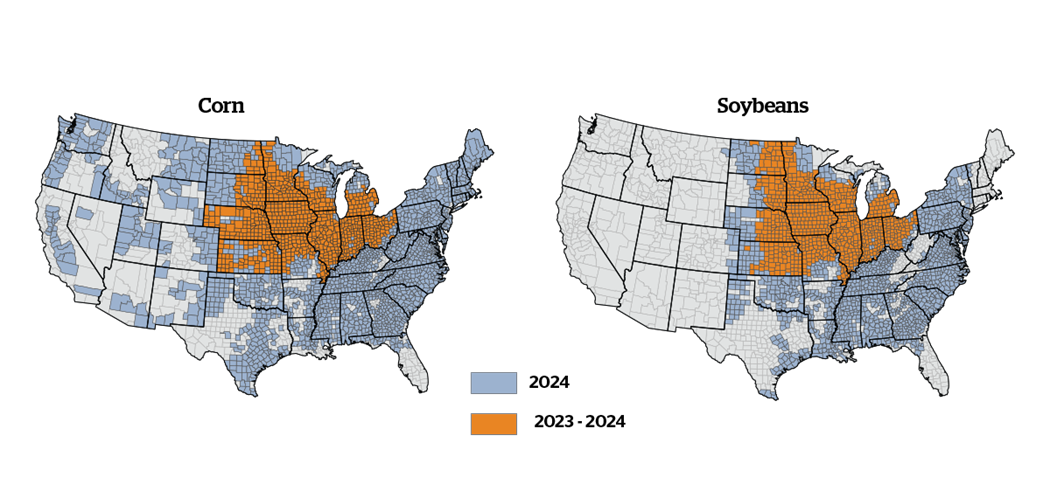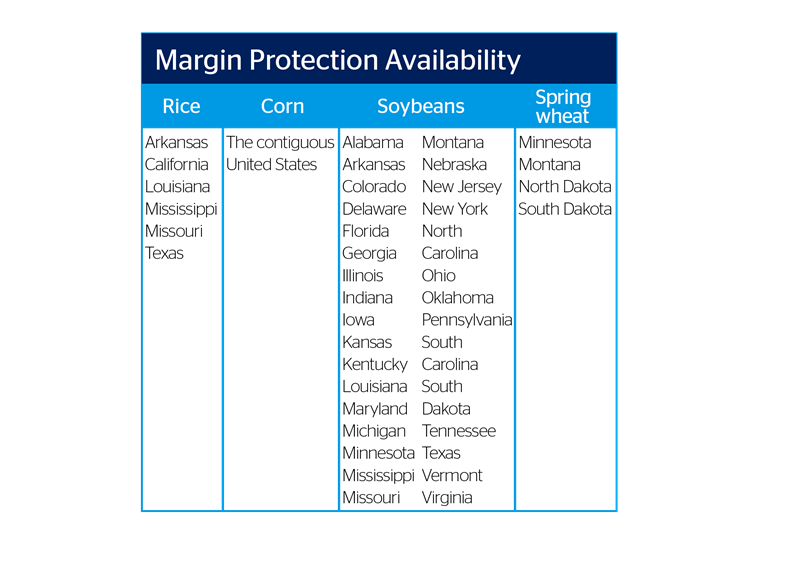Margin Protection plan of insurance
Margin Protection (MP) is an area-based* insurance plan that provides coverage against an unexpected decrease in operating margin (revenue less input costs), caused by reduced county yields, reduced commodity prices, increased prices of certain inputs, or any combination of these perils. Since Margin Protection is area-based (average for a county), an individual farm may have a decrease in its margin, but may not receive an indemnity or vice-versa.
*Margin Protection is based on Production Area, which many times is equivalent to the county. However, it is important to remember that they can differ.
Other Insurance
Margin Protection can be purchased by itself or in conjunction with a Yield Protection (YP) or a Revenue Protection (RP) policy. Growers who purchase a YP or RP policy get a premium credit on the Margin Protection premium and receive the greater of the Margin Protection or RP indemnity in the fall. MPCI base YP or RP policy MUST be with the SAME Approved Insurance Provider. The credit is the actuarially determined value of the expected overlapping indemnities between Margin Protection and RP at the time of RP sales closing.
Coverage Availability
Margin Protection is available in select counties for rice, corn, soybeans, and spring wheat in the states listed below. The USDA released an expansion that will add 1,255 counties for soybeans and 1,729 counties for corn. To view maps displaying the expansion, scroll down to the "USDA Expansion Maps" section of this page. The MP county lists by crop are available at www.marginprotection.com. Scroll down the page until you see the section titled “Downloadable Content”. You can also reference RMA’s Actuarial Information Browser.
Margin Protection Basics
Margin Protection provides coverage that is based on an expected margin for each applicable crop, type, and practice.
Expected Margin = Expected Revenue ˗ Expected Costs, where:
- Expected Revenue (per acre) is the Expected Area Yield multiplied by a projected commodity price; and
- Expected Cost (per acre) is the dollar amount determined by multiplying the quantity of each allowed input by the input’s projected price.
Trigger Margin = Expected Margin ˗ Deductible
The deductible is 1.00 minus the coverage level multiplied by the Expected Revenue.
Margin Protection offers coverage levels from 70% to 95% and protection factors from 0.80 to 1.20.
Margin Protection can be purchased with the Harvest Price Option (MP-HPO). Under MP-HPO, if the harvest price exceeds the projected price, the Expected Revenue used in setting trigger margins is reset based on the harvest price.
Why Boost with Margin Protection?
- Area-based* coverage that uses the same expected and final yields as Area Risk Protection Insurance (ARPI), Supplemental Coverage Option (SCO), Margin Coverage Option (MCO), and Enhanced Coverage Option (ECO) policies.
- Offers coverage up to 95%, the highest subsidized level of coverage available.
- Offers a protection factor of up to 1.2, which means a loss in margin could be multiplied by 1.2 for payment.
Margin Protection Concepts
Prior to the SCD, RMA releases in the actuarial documents for each county:
- Expected Area Yield
- Projected Price
- Expected Cost
- Expected Margin is calculated
After Harvest, RMA releases in the actuarial documents for each county:
- Final Area Yield
- Harvest Price
- Harvest Cost
- Harvest Margin is calculated
Expected Costs
When determining the margin, two types of inputs are considered:
- Those not subject to price change (i.e. fixed from planting to harvest); and
- Inputs subject to price changes.
Inputs not subject to price change are not specifically identified, but include: seed, machinery, operating costs (other than fuel), and similar expenses.
Inputs subject to price change are identified in the Margin Protection provisions and include the following:
Crop | Allowed Inputs Subject to Price Change |
Corn | Diesel, Urea, Diammonium Phosphate price (DAP), Potash, Interest |
Soybeans | Diesel, DAP, Potash, Interest |
Rice | Diesel, Urea, DAP, Potash, Interest |
Spring wheat | Diesel, Urea, Monoammonium Phosphate (MAP), Potash, Interest |
Margin Protection simple example
Calculating an MP Trigger at 95% coverage level
Commodity price and bushel decrease
Expected Margin
(Expected Yield x Projected Price) ˗ Expected Cost
(180 bu./acre x $5.00) - $432.50/acre = $467.50/acre
Margin Deductible
Expected Revenue x (1 ˗ Coverage Level)
(180 bu./acre x $5.00) x (1 - 95%) = $45/acre
Trigger Margin
Expected Margin ˗ Margin Deductible
$467.50/acre - $45/acre = $422.50/acre
Calculating an MP Indemnity with a 1.20 Protection Factor
Harvest Margin
(Harvest Yield x Harvest Price) ˗ Harvest Cost
(160 bu./acre x $4.80) - $432.50/acre = $335.50/acre
Margin Loss
Trigger Margin ˗ Harvest Margin
$422.50/acre - $335.50/acre = $87/acre
Margin Indemnity
Margin Loss x Protection Factor
$87/acre x 1.20 = $104.40/acre
Margin Protection example with MP-HPO
Calculating an MP Trigger at 95% coverage level
Commodity price increase and bushel decrease
Expected Margin
(Expected Yield x max{Proj, Harv}) ˗ Expected Cost
(180 bu./acre x max{$5.00, $5.10}) - $432.50/acre = $485.50/acre
Margin Deductible
Expected Revenue x (1 - Coverage Level)
(180 bu./acre x $5.10) x (1 - 95%) = $45.90/acre
Trigger Margin
Expected Margin ˗ Margin Deductible
$485.50/acre - $45.90/acre = $439.60/acre
Calculating an MP Indemnity with a 1.20 Protection Factor
Harvest Margin
(Harvest Yield x Harvest Price) ˗ Harvest Cost
(160 bu./acre x $5.10) ˗ $432.50/acre = $383.50/acre
Margin Loss
Trigger Margin ˗ Harvest Margin
$439.60/acre ˗ $383.50/acre = $56.10/acre
Margin Indemnity
Margin Loss x Protection Factor
$56.10/acre x 1.20 = $67.32/acre
Note: The Margin Harvest Price will not be greater than the Margin Projected Price multiplied by 2.00.
Payments
Any indemnities owed will be paid when Final County Yields are available, in the spring of the following year.
USDA Expansion Maps

Training Materials
- Revenue IQ Margin Protection Is Still a Great Deal, and Expanded for 2024
- NAU Country Connection Webinar - 2024 Margin Protection Expansion
- Margin Protection Training PPT (in PDF format)
- Thinking Cap - Margin Protection for 2024 (September 2024)
Promotional Tools
- 2024 Margin Protection Expansion Handout
- Margin Protection Indemnity Matrix Tool (login required - access in your downloads file)
- Margin Protection Brochure
- Margin Protection Sales Postcard
Resources
- USDA Expands Margin Protection for Corn and Soybean Farmers
- RMA Premium Estimator for Margin Protection
- RMA Frequently Asked Questions
- RMA Fact Sheet
- Margin Protection Plan Insurance Standards Handbook
- Margin Protection Plan Policy
- Margin Protection Plan Corn Crop Provisions
- Margin Price Provisions Corn
- Margin Protection Plan Rice Crop Provisions
- Margin Price Provisions Rice
- Margin Protection Plan Soybean Crop Provisions
- Margin Price Provisions Soybean
- Margin Protection Plan Wheat Crop Provisions


